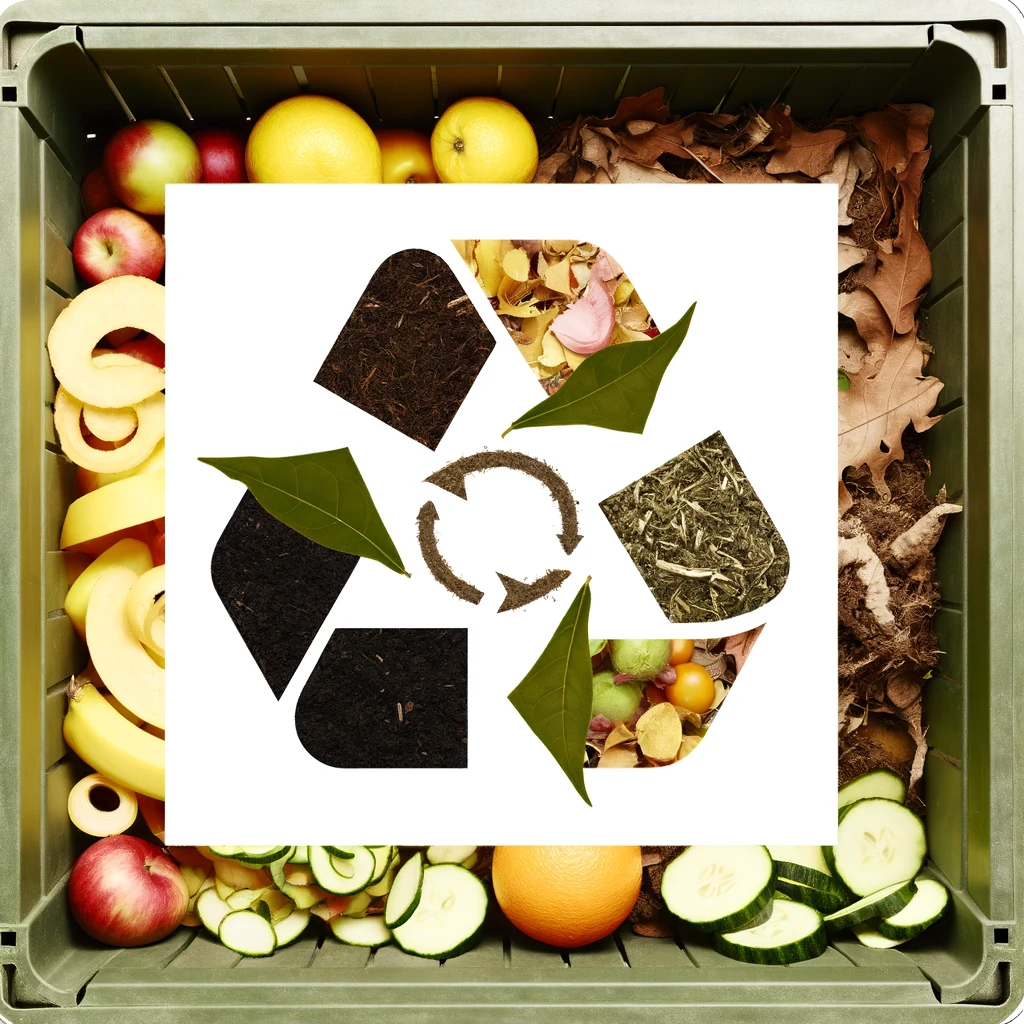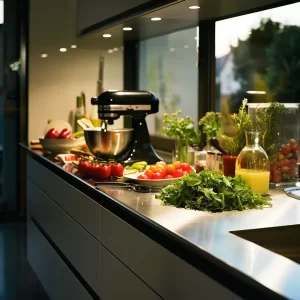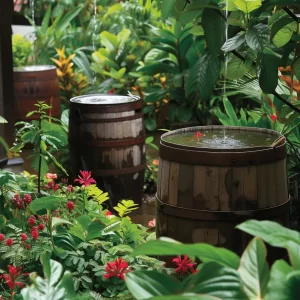What is Bokashi Composting: Ultimate Guide
As the saying goes, ‘Waste not, want not.’ If you’re looking to turn your kitchen leftovers into a valuable resource, Bokashi composting presents an efficient and eco-friendly solution.
This method, hailing from Japan, allows you to ferment your food waste indoors without the odor or inconvenience of traditional composting methods. By layering scraps with a special mix, you’re on your way to producing nutrient-rich soil.
However, as straightforward as it may seem, there are nuances to mastering the Bokashi process. Stick around to uncover the secrets to avoiding common pitfalls and maximizing the benefits of this unique composting technique.
Table of Contents
Key Takeaways
- Bokashi composting is a fast, indoor-friendly method that ferments all food waste into soil enhancer in 2-4 weeks.
- It utilizes a simple setup with a Bokashi bucket and bran for odor-free, eco-friendly composting.
- By layering kitchen scraps with Bokashi bran, it employs anaerobic fermentation, reducing methane production and enriching soil.
- The process produces nutrient-rich Bokashi tea, offering additional benefits for plant growth and creative compost uses.
What is Bokashi Composting?
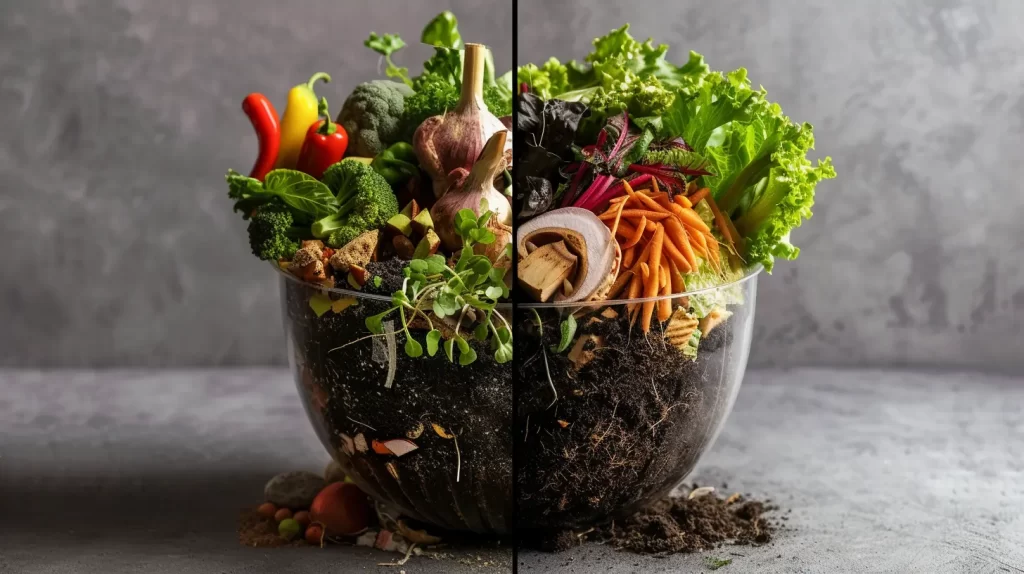
You might wonder what Bokashi composting is and how it can fit into your eco-friendly routine.
It’s a method where you layer your kitchen scraps with a special inoculant to ferment the waste, not just decompose it.
This process, developed in Japan, transforms your food waste into nutrient-rich soil enhancer in a more compact, indoor-friendly system.
Understanding the Bokashi Method
Bokashi composting, a method developed in Japan, transforms your kitchen scraps into nutrient-rich soil through a unique fermentation process. Unlike traditional composting, Bokashi composting lets you compost all kinds of food waste, including meat and dairy, without odors. Here’s what makes it stand out:
- Speed: It’s a quick process, taking about two to four weeks to ferment kitchen waste before it can be buried or further processed.
- Simplicity: You don’t need a large outdoor space or complex setup. All you need is a Bokashi bucket and some Bokashi bran.
- Sustainability: It reduces methane production by fermenting waste anaerobically, making it an eco-friendlier option compared to letting food waste decompose in landfills.
How to Use a Bokashi Bucket?
Understanding the benefits and unique aspects of the Bokashi composting method sets the stage for learning how to effectively use a Bokashi bucket in your own home. Essentially, a Bokashi bucket is an airtight container designed to transform your kitchen waste into compost with the help of a special inoculant.
You’ll start by placing a layer of food scraps in the bucket, then sprinkle a layer of Bokashi bran over it. It’s crucial to repeat this layering process until the bucket is full, ensuring each layer of scraps is well covered with the bran. Press down the contents to remove air pockets, which helps create an anaerobic environment. Finally, seal the bucket tight.
This method not only keeps odors at bay but also accelerates the composting process.
Getting Started with Bokashi Composting
To get started with Bokashi composting, it’s essential to first assemble or purchase a composting kit tailored for this method. This unique form of composting transforms your kitchen scraps into nutrient-rich soil enhancer through an anaerobic fermentation process.
Here’s a quick guide to dive in:
- Choose Your Kit: Either build your own or buy a ready-made Bokashi composting kit. Make sure it’s airtight!
- Prep Your Scraps: Chop your food waste into smaller pieces to speed up the fermentation process.
- Layer and Sprinkle: Alternately layer your scraps with Bokashi bran in the bin. Every layer of waste gets a sprinkle of bran to kickstart the fermentation.
Benefits of Bokashi Composting
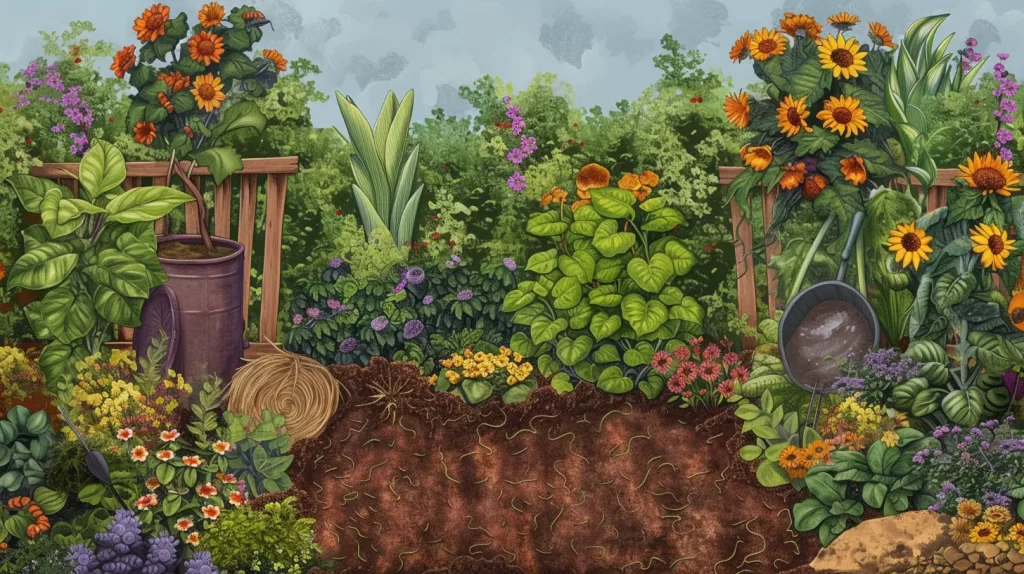
Let’s explore the benefits you’ll experience with Bokashi composting.
You’ll find that composting kitchen scraps becomes effortless, allowing you not just to reduce waste but to create nutrient-rich bokashi tea for your plants.
Additionally, we’ll look at how it stands up against traditional composting systems, highlighting its unique advantages.
Composting Kitchen Scraps with Bokashi
Composting kitchen scraps with Bokashi turns everyday waste into nutrient-rich soil enhancer efficiently and effectively. Here’s why it’s a game-changer in managing kitchen waste:
- Speed: Bokashi composting is faster than traditional methods. The fermentation process takes just two weeks, after which you can bury the pre-compost in your garden soil, transforming it in about two more weeks.
- Odorless: Unlike traditional composting, Bokashi is practically odor-free, thanks to the anaerobic fermentation process. You can keep the bin indoors without worrying about unpleasant smells.
- Versatility: You can compost almost all types of kitchen waste, including dairy and meat, which are usually not recommended for aerobic composting systems.
This method not only simplifies waste management but also enriches your garden soil, making it a win-win.
Creating Bokashi Tea
One remarkable benefit of bokashi composting is your ability to create nutrient-rich bokashi tea, a byproduct that can significantly enhance plant growth. This ‘tea’ is essentially a liquid fertilizer, brimming with beneficial microorganisms. As you maintain your bokashi bin, the anaerobic process produces this valuable liquid. You can tap it off every few days, diluting it with water to create a potent solution for your plants.
Using bokashi tea offers a quick nutrient boost, making it ideal for plants needing immediate attention. It’s especially effective for both indoor and outdoor plants, enriching soil health and promoting vigorous growth. Remember, applying it directly without dilution might harm sensitive plants due to its strength, so always dilute it properly before use.
Comparison with Traditional Composting Systems
After exploring the unique benefits of creating bokashi tea, it’s crucial to understand how bokashi composting stands apart from traditional composting systems. Unlike the latter, bokashi composting offers several unique advantages that cater to different needs and environments.
Here’s a quick comparison to highlight its benefits:
- Speed: Bokashi composting accelerates the breakdown of organic matter, transforming kitchen waste into compost in just weeks, while traditional methods can take months.
- Versatility: You can compost almost all types of organic waste, including dairy and meat, which are typically not recommended for aerobic systems.
- Odor and Space: Bokashi composting is virtually odor-free and perfect for small spaces, making it ideal for indoor use.
Understanding these differences can help you decide if bokashi composting is the right choice for your composting needs.
Setting Up a Bokashi Composting System
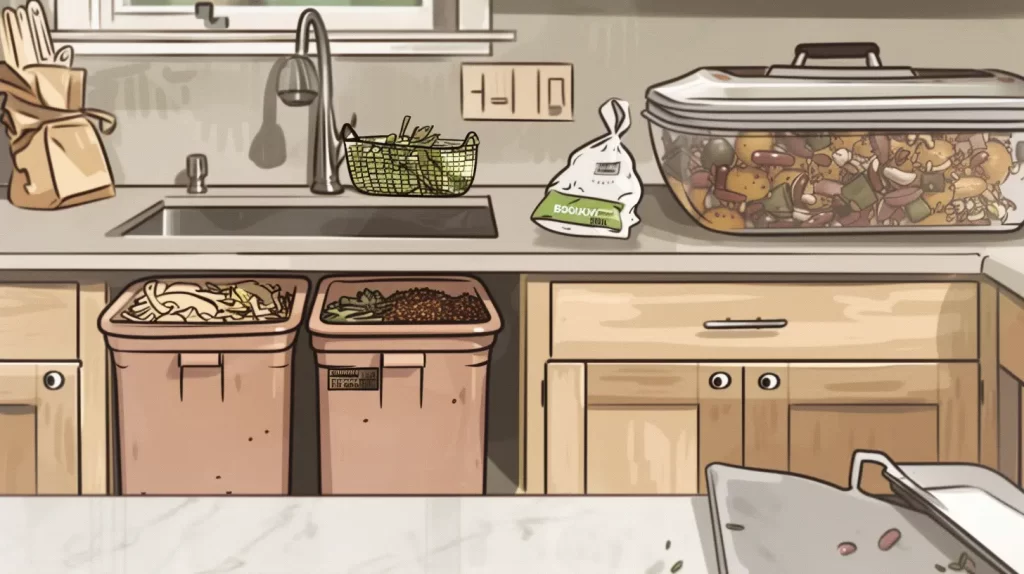
Now that you’re familiar with the benefits of Bokashi composting, it’s time to get your system up and running.
You’ll start by choosing the right setup and learning to add your food scraps properly to the Bokashi bin.
For more detailed guidance, don’t forget to subscribe to our YouTube channel.
How to Start with Bokashi?
Are you wondering how to start with Bokashi composting and set up your own system at home? It’s simpler than you might think, and you’ll be on your way to reducing waste and enriching your garden soil in no time. Here’s a quick guide to get you started:
- Choose a Bokashi Bin: You can either purchase a ready-made Bokashi composting kit or make your own. Ensure it’s airtight to create the anaerobic environment needed for fermentation.
- Get Bokashi Bran: This is the accelerator for your compost. It contains the effective microorganisms necessary to break down your food waste.
- Find the Perfect Spot: Your Bokashi bin should be kept in a location that’s out of direct sunlight and at room temperature to optimize the fermentation process.
Adding Food Waste to the Bokashi Bin
Once you’ve chosen your Bokashi bin and bran, it’s time to start adding your food waste. Begin by chopping your kitchen scraps into smaller pieces. This speeds up the fermentation process.
For every layer of waste you add, sprinkle a generous amount of Bokashi bran over it. This ensures your scraps are well-coated with the inoculant needed for fermentation.
After adding a layer of waste and bran, press down firmly. This step is crucial; it removes any air pockets, creating an anaerobic environment ideal for the Bokashi process.
Subscribing to Our YouTube Channel for More Tips
For more in-depth guidance on setting up your Bokashi composting system, make sure you subscribe to our YouTube channel. We’ve got all the tips and tricks you’ll need to get started, along with visual demonstrations that’ll make the process clearer and more manageable. Here’s a sneak peek of what you’ll find:
- Step-by-Step Setup Instructions: From choosing the right bin to layering your kitchen scraps with Bokashi bran, we break it down for you.
- Troubleshooting Common Issues: We’ll show you how to handle too much moisture or not enough fermentation.
- Creative Uses for Bokashi Compost: Discover how to use your pre-compost in your garden, make Bokashi tea, and more.
Don’t miss out on these practical insights—subscribe today and turn your kitchen scraps into garden gold!
How Bokashi Composting Works
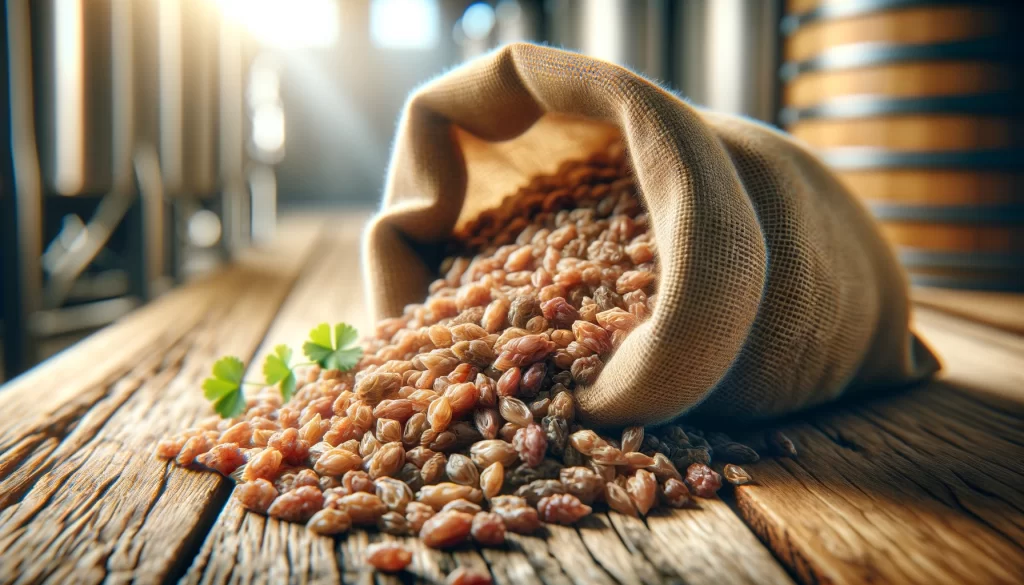
You’ll now explore how bokashi composting transforms your kitchen scraps into nutrient-rich compost.
Understanding the fermentation process and the role of effective microorganisms is key to turning waste into compost with bokashi.
This method efficiently processes all your food scraps, including dairy and meat, unlike traditional composting techniques.
Understanding the Fermentation Process
At the heart of bokashi composting lies a unique fermentation process that transforms your kitchen scraps into nutrient-rich soil enhancer. Unlike traditional composting, bokashi composting is an anaerobic process, meaning it occurs in the absence of air.
- Layering: You start by layering your kitchen waste with bokashi bran in a specialized bin. This mixture creates an environment ripe for fermentation.
- Sealing: Once your bin is full, it’s sealed tight. This lack of oxygen is crucial for the fermentation process to kick off.
- Waiting: You’ll need to let the bin sit for about two weeks. During this time, the contents ferment, turning your scraps into a pre-compost material, ready for the next steps in your gardening adventures.
Effective Microorganisms in Bokashi
One of the keys to bokashi composting’s effectiveness lies in its use of effective microorganisms that accelerate the fermentation of organic waste. These microorganisms, a blend of bacteria, yeasts, and fungi, work together to break down your kitchen scraps without the need for oxygen.
You’re essentially creating an environment where these beneficial microbes thrive, speeding up the decomposition process. By adding a bokashi bran, rich in these microorganisms, to your food waste, you’re kickstarting a fermentation process.
This method doesn’t just reduce the volume of your waste; it also ensures that the nutrients in your food scraps are preserved, making the end product a highly nutritious soil amendment. It’s a compact, odorless system that fits right into your kitchen routine.
Transforming Food Scraps to Compost with Bokashi
Having explored the role of effective microorganisms in bokashi composting, let’s now uncover how these elements transform your food scraps into nutrient-rich compost. The process is surprisingly simple and efficient, turning your kitchen waste into a valuable resource for your garden.
Here’s how it works:
- Layering: Start by adding a layer of food scraps to your bokashi bin, followed by a sprinkling of bokashi bran. The bran is packed with microorganisms that kickstart the fermentation process.
- Sealing: Press down to remove any air pockets and seal the bin tightly. This anaerobic environment is crucial for fermentation.
- Waiting: Let the bin sit for about two weeks. During this time, the microorganisms work their magic, fermenting the scraps and producing a pre-compost mixture.
You’ll end up with a potent pre-compost ready to enrich your garden soil.
Troubleshooting and Maintenance
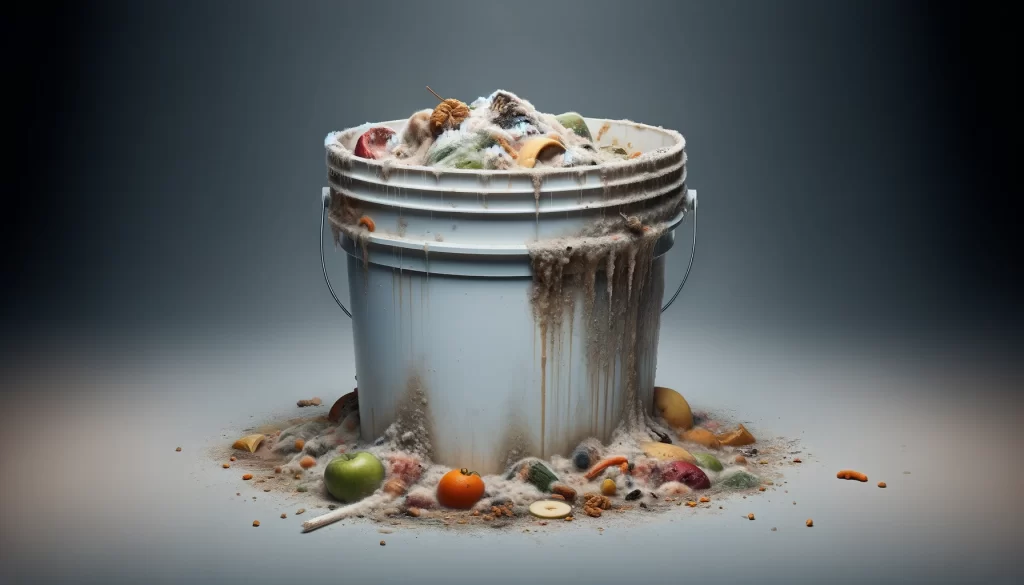
As you maintain your bokashi composting system, you may run into a few common issues such as managing compost odor, dealing with rotting food, or ensuring your bins remain airtight.
We’ll offer tips for inoculating your bokashi for optimal results, helping you overcome these challenges.
Keep in mind, proper maintenance and troubleshooting are key to a successful composting process.
Dealing with Airtight Bins
Managing airtight bins in bokashi composting requires attention to detail to prevent issues like mold and bad odors. To ensure your composting journey is smooth, follow these three essential tips:
- Regularly Check Seals: Make sure the bin’s lid is tightly sealed after each use. A proper seal keeps oxygen out and ensures an anaerobic environment, crucial for the bokashi process.
- Clean Edges and Lid: After adding scraps and bokashi bran, wipe down any residue on the bin’s edges or under the lid. This prevents mold growth and attracts fewer pests.
- Monitor Moisture Levels: Too much moisture can compromise the fermentation. If you notice excess liquid, add more bokashi bran or dry material to balance the moisture content.
Managing Compost Odor and Rotting Food
To effectively combat compost odor and prevent food from rotting, it’s crucial to identify and address the underlying issues promptly. If you’re noticing a foul smell, it’s likely that your bokashi bin isn’t anaerobic enough. Ensure the lid is tightly sealed and you’re pressing down the waste to remove any air pockets.
Too much moisture can also lead to bad odors and rot. If your compost looks too wet, mix in more bokashi bran to absorb excess moisture. Remember, balance is key. Your bin should have a slight sweet-sour smell, not a putrid one.
Regularly check for leaks and ensure your bin’s spigot is functioning correctly to drain the bokashi tea, preventing over-saturation. With these steps, you’ll keep odors at bay and ensure successful composting.
Tips for Inoculating Bokashi For Optimal Results
Ensuring your bokashi composting process achieves optimal results begins with proper inoculation techniques and regular maintenance. Here are three crucial tips to keep in mind:
- Balance is key: Ensure there’s a good mix of bokashi bran and kitchen scraps. Too little bran won’t ferment all the scraps, while too much is wasteful.
- Press down firmly: After adding your scraps and bran, press down to remove any air pockets. This anaerobic environment is crucial for fermentation.
- Monitor moisture levels: Your bokashi bin should be moist but not wet. If it’s too dry, add a bit more fresh scraps or a very small amount of water. If too wet, mix in more bokashi bran to absorb excess moisture.
Regularly following these steps will help you avoid common pitfalls and maintain a healthy bokashi composting system.
Expanding Your Bokashi Composting Knowledge
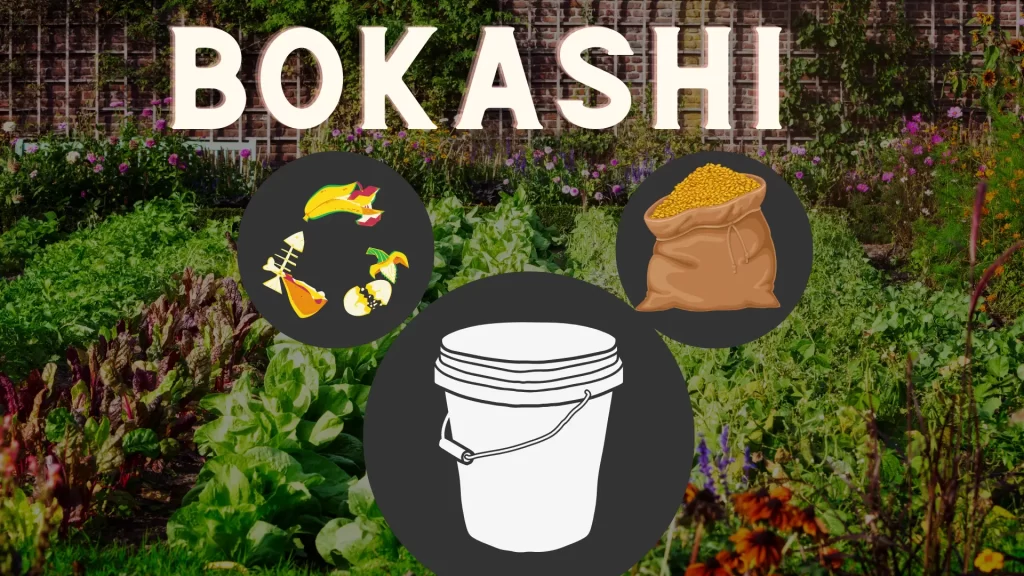
As you’ve gotten familiar with the basics of Bokashi composting, it’s time to broaden your expertise.
You’ll explore how to enrich your garden with Bokashi compost tea, seamlessly transition your pre-compost into final compost, and uncover advanced techniques through engagement with Bokashi experts.
These steps will elevate your composting practice and contribute significantly to your gardening success.
Using Bokashi Compost Tea in the Garden
One effective way to enrich your garden’s soil is by using bokashi compost tea, a nutrient-packed liquid resulting from your bokashi composting efforts. This tea is a byproduct of the fermentation process, loaded with beneficial microorganisms. Here’s how to use it in your garden effectively:
- Dilute the Tea: Always dilute the bokashi tea with water, typically at a ratio of 1:100 (tea to water), before applying to your plants.
- Feed Your Plants: Use the diluted tea to water your plants, providing them with a nutrient boost that supports their growth and health.
- Target the Soil: Focus on pouring the tea directly onto the soil around your plants, avoiding the leaves to prevent any potential leaf burn from the concentrated nutrients.
This simple method can significantly enhance your garden’s vitality.
Transitioning from Pre-Compost to Final Compost
After your bokashi bin has fermented for two weeks, it’s time to transition the pre-compost into its final, nutrient-rich soil form.
You’ll need to dig a trench or hole in your garden where you can bury the pre-compost. Ensure it’s at least 12 inches deep to avoid attracting pests and to facilitate the breakdown process.
Mix the pre-compost with the soil to help integrate the beneficial microorganisms and speed up decomposition. Cover it well with soil.
Over the next two to four weeks, these microorganisms will convert the pre-compost into a rich, fertile soil amendment. You’ll notice the soil where you buried the pre-compost becomes darker, looser, and more nutrient-dense, perfect for planting your next batch of plants.
Exploring Advanced Bokashi Techniques with Bokashi Experts
Now that you’re familiar with turning pre-compost into nutrient-rich soil, let’s explore some advanced techniques from bokashi experts to enhance your composting knowledge. Diving deeper into the bokashi method can significantly improve your composting efficiency and outcomes. Here are a few tips:
- Layer Wisely: Alternate between thicker food waste layers and bokashi bran to accelerate fermentation and ensure an even distribution of microbes.
- Monitor Moisture: Aim for a slightly moist environment within your bin. Too dry, and the fermentation slows; too wet, and you risk bad odors. Adjust by adding dry material or draining liquid as necessary.
- Extend Fermentation: For tougher materials like bones or seafood shells, consider extending the fermentation period beyond two weeks for complete breakdown.

Bamboo FAQ
Q: What is the bokashi process and how does it differ from traditional composting?
A: Bokashi composting is a process that uses bokashi starter, which contains beneficial bacteria, yeast, and fungi to ferment organic waste in a sealed container, called a bokashi composter. Unlike normal composting methods that rely on decomposition, bokashi is an anaerobic (oxygen-free) process. So while a hot compost pile might take longer to ferment, the bokashi process could transform your scraps into compost very quickly. Bokashi is a Japanese word that roughly translates to ‘fermented organic matter’, reflecting the nature of Bokashi composting.
Q: How do I start using the bokashi system in my home composting?
A: Starting your home composting with a bokashi system requires a bokashi composter, or a compost bin, and a bokashi starter. You can start by adding your kitchen scraps into the bokashi compost bin, layering it with a handful of bokashi starter (or as directed). Once the bokashi bin is full, seal it tightly and let it ferment for a couple weeks. Don’t forget to regularly drain off the liquid that forms, which can be used as a liquid fertilizer.
Q: What is bokashi living and how can I implement it?
A: Bokashi living refers to the approach of regularly using the bokashi process to compost all of your food scraps into compost. It’s an easy and efficient way to compost nutrients back into your garden soil, especially for those without a traditional compost pile. All you need is a bokashi composter and bokashi starter to get started at home.
Q: Where can I get premium bokashi bran and does it have any specific benefits?
A: Premium bokashi bran can be bought from various gardening suppliers or online. This superior bran is infused with the bokashi inoculant, containing beneficial microorganisms that accelerate the composting process and enrich your compost with nitrogen and micronutrients, beneficial for any gardener.
Q: What does it mean to compost your food and how does the bokashi kitchen composting system help?
A: Composting is a process where food waste is transformed into nutrient-rich soil improver, ideal for gardening. The bokashi kitchen composting system is particularly useful for this as it effectively composts all kitchen scraps, including things like meat and dairy that aren’t recommended for a traditional hot compost pile, making it a versatile and ecological way to compost.
Q: What if white mold starts appearing in my bokashi composter?
A: White mold on your bokashi pre-compost is a good sign and it shows the fermentation process is working well. This is one of the unique characteristics of bokashi composting due to its anaerobic nature.
Q: Where can I find more detailed instructions on how to use the bokashi system?
A: You can often find detailed user guides or video tutorials on retailer’s websites where you bought your bokashi system. Alternatively, for more tips and tricks, you can subscribe to relevant YouTube channels or check back to the blogs of the gardening community.

